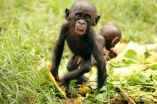(Press-News.org) Bonobos voluntarily share food and will even forego their own meals for a stranger, but only if the recipient offers them social interaction, according to research published January 2 by Jingzhi Tan and Brian Hare of Duke University.
In a series of experiments, the researchers found that bonobos would voluntarily forego their food and offer it to a stranger in exchange for social interaction. The authors found that the bonobos' behavior was at least partially driven by unselfish motivations, since the animals helped strangers acquire food that was out of reach even when no social interaction was possible as a result of helping them. However, their generosity had its limits: Animals would not share food in their possession if no social interaction was possible.
Though the study subjects were all bonobos that had been orphaned by the bushmeat trade in Congo, they showed no significant psychological differences from bonobos that had been raised by their mothers. According to the authors, their results reveal the evolution of generosity in these apes, our closest living relatives. They suggest that the behavior may have evolved to allow for the expansion of individual social networks.
Lead author Tan adds, "Our results show that generosity toward strangers is not unique to humans. Like chimpanzees, our species would kill strangers; like bonobos, we could also be very nice to strangers. Our results highlight the importance of studying bonobos to fully understand the origins of such human behaviors."
INFORMATION:
Citation: Tan J, Hare B (2013) Bonobos Share with Strangers. PLOS ONE 8(1): e51922. doi:10.1371/journal.pone.0051922
Financial Disclosure: This work was supported by the ERC #233297 and NSF-BCS-27552; NSF-BCS-25172 to Brian Hare. The funders had no role in study design, data collection and analysis, decision to publish, or preparation of the manuscript.
Competing Interest Statement: The authors have declared that no competing interests exist.
PLEASE LINK TO THE SCIENTIFIC ARTICLE IN ONLINE VERSIONS OF YOUR REPORT (URL goes live after the embargo ends): http://dx.plos.org/10.1371/journal.pone.0051922
Food for friendship: Bonobos share with strangers in exchange for company
Bonobos share food, will forgo their own meals for the company of strangers
2013-01-03
ELSE PRESS RELEASES FROM THIS DATE:
ALMA sheds light on planet-forming gas streams
2013-01-03
Astronomers using the Atacama Large Millimeter/submillimeter Array (ALMA) telescope have seen a key stage in the birth of giant planets for the first time. Vast streams of gas are flowing across a gap in the disc of material around a young star. These are the first direct observations of such streams, which are expected to be created by giant planets guzzling gas as they grow. The result is published on 2 January 2013 in the journal Nature.
The international team of astronomers studied the young star HD 142527, over 450 light-years from Earth, which is surrounded by a ...
Nature: Political action the biggest swing factor in meeting climate targets
2013-01-03
The new study, published today in the journal Nature, examined the probability of keeping average global temperatures from rising more than 2°C above preindustrial levels under varying levels of climate policy stringency, and thus mitigation costs. In addition, the study for the first time quantified and ranked the uncertainties associated with efforts to mitigate climate change, including questions about the climate itself, uncertainties related to future technologies and energy demand, and political uncertainties as to when action will be taken.
The climate system itself ...
Our galaxy's 'geysers' are towers of power
2013-01-03
VIDEO:
This is Ettore Carretti talking about how the telescope makes maps of the sky.
Click here for more information.
"Monster" outflows of charged particles from the centre of our Galaxy, stretching more than halfway across the sky, have been detected and mapped with CSIRO's 64-m Parkes radio telescope.
Corresponding to the "Fermi Bubbles" found in 2010, the outflows were detected by astronomers from Australia, the USA, Italy and The Netherlands. The finding is reported ...
Study refutes accepted model of memory formation
2013-01-03
A study by Johns Hopkins researchers has shown that a widely accepted model of long-term memory formation — that it hinges on a single enzyme in the brain — is flawed. The new study, published in the Jan. 2 issue of Nature, found that mice lacking the enzyme that purportedly builds memory were in fact still able to form long-term memories as well as normal mice could.
"The prevailing theory is that when you learn something, you strengthen connections between your brain cells called synapses," explains Richard Huganir, Ph.D., a professor and director of the Johns Hopkins ...
ALMA shows how young star and planets grow simultaneously
2013-01-03
Astronomers have used the ALMA telescope to get their first glimpse of a fascinating stage of star formation in which planets forming around a young star are helping the star itself continue to grow, resolving a longstanding mystery. The young system, about 450 light-years from Earth, is revealing its complex gravitational dance to the ever-sharpening vision of the Atacama Large Millimeter/submillimeter Array (ALMA), scheduled for completion this year.
As young stars gather material from their surrounding clouds of gas and dust, the incoming material forms a flat, spinning ...
Galactic geysers fuelled by star stuff
2013-01-03
Enormous outflows of charged particles from the centre of our Galaxy, stretching more than halfway across the sky and moving at supersonic speeds, have been detected and mapped with CSIRO's 64-m Parkes radio telescope.
Corresponding to the "Fermi Bubbles" found in 2010, the recent observations of the phenomenon were made by a team of astronomers from Australia, the USA, Italy and The Netherlands, with the findings reported in today's issue of Nature.
"There is an incredible amount of energy in the outflows," said co-author Professor Lister-Staveley-Smith from The University ...
The laws of global warming
2013-01-03
With policymakers and political leaders increasingly unable to combat global climate change, more scientists are considering the use of manual manipulation of the environment to slow warming's damage to the planet.
But a University of Iowa law professor believes the legal ramifications of this kind of geo-engineering need to be thought through in advance and a global governance structure put in place soon to oversee these efforts.
"Geo-engineering is a global concern that will have climate and weather impacts in all countries, and it is virtually inevitable that some ...
Communication is key to medication adherence
2013-01-03
Even the best medicines in the world can be rendered ineffective if they are not taken as prescribed. The problem known as medication "non-adherence" is a major health issue in the United States, contributing to worse outcomes for people who have diabetes and other chronic diseases.
Now a study led by researchers at the University of California, San Francisco (UCSF), San Francisco General Hospital and Trauma Center (SFGH) and the Kaiser Permanente Division of Research has identified a significant factor that contributes to poor drug adherence – ineffective communication.
Described ...
Bisexual men on the 'down low' run risk for poor mental health
2013-01-03
January 2, 2013 -- Bisexual men are less likely to disclose and more likely to conceal their sexual orientation than gay men. In the first study to look at the mental health of this population, researchers at Columbia University's Mailman School of Public Health found that greater concealment of homosexual behavior was associated with more symptoms of depression and anxiety.
The study published in the American Psychological Association's Journal of Consulting and Clinical Psychology, examined bisexual men "on the down low," a subgroup of bisexual men who live predominantly ...
Common data determinants of recurrent cancer are broken, mislead researchers
2013-01-03
In order to study the effectiveness or cost effectiveness of treatments for recurrent cancer, you first have to discover the patients in medical databases who have recurrent cancer. Generally studies do this with billing or treatment codes – certain codes should identify who does and does not have recurrent cancer. A recent study published in the journal Medical Care shows that the commonly used data determinants of recurrent cancer may be misidentifying patients and potentially leading researchers astray.
"For example, a study might look in a database for all patients ...
LAST 30 PRESS RELEASES:
Structure of dopamine-releasing neurons relates to the type of circuits they form for smell-processing
Reducing social isolation protects the brain in later life
Keeping the heart healthy increases longevity even after cancer
Young adults commonly mix cannabis with nicotine and tobacco
Comprehensive review illuminates tau protein's dual nature in brain health, disease, and emerging psychiatric connections
Book prepares K-12 leaders for the next public health crisis
Storms in the Southern Ocean mitigates global warming
Seals on the move: Research reveals key data for offshore development and international ecology
Sports injuries sustained during your period might be more severe
World's first successful 2 Tbit/s free-space optical communication using small optical terminals mountable on satellites and HAPS
Can intimate relationships affect your heart? New study says ‘yes’
Scalable and healable gradient textiles for multi‑scenario radiative cooling via bicomponent blow spinning
Research shows informed traders never let a good climate crisis go to waste
Intelligent XGBoost framework enhances asphalt pavement skid resistance assessment
Dual-function biomaterials for postoperative osteosarcoma: Tumor suppression and bone regeneration
New framework reveals where transport emissions concentrate in Singapore
NTP-enhanced lattice oxygen activation in Ce-Co catalysts for low-temperature soot combustion
Synergistic interface engineering in Cu-Zn-Ce catalysts for efficient CO2 hydrogenation to methanol
COVID-19 leaves a lasting mark on the human brain
Scientists use ultrasound to soften and treat cancer tumors without damaging healthy tissue
Community swimming program for Black youth boosts skills, sense of belonging, study finds
Specific depressive symptoms in midlife linked to increased dementia risk
An ‘illuminating’ design sheds light on cholesterol
Who is more likely to get long COVID?
Study showcases resilience and rapid growth of “living rocks”
Naval Research Lab diver earns Office of Naval Research 2025 Sailor of the Year
New Mayo-led study establishes practical definition for rapidly progressive dementia
Fossil fuel industry’s “climate false solutions” reinforce its power and aggravate environmental injustice
Researchers reveal bias in a widely used measure of algorithm performance
Alcohol causes cancer. A study from IOCB Prague confirms damage to DNA and shows how cells defend against it
[Press-News.org] Food for friendship: Bonobos share with strangers in exchange for companyBonobos share food, will forgo their own meals for the company of strangers

